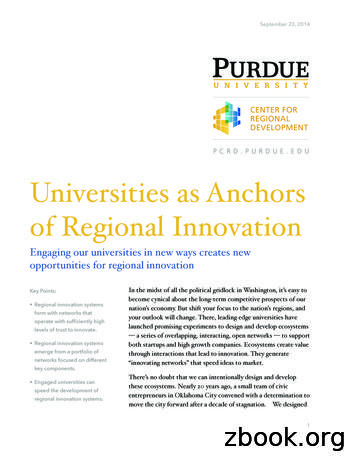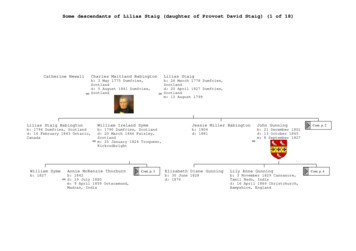Regional Universities – Opportunities And Challenges, A .
Regional Universities – Opportunitiesand Challenges, a Regional UniversitiesNetwork (RUN) perspectiveDr Caroline Perkins, ExecutiveDirector, RUN
OPPORTUNITIES AND CHALLANGES Regional Environment Political and FundingEnvironment RUN activities
REGIONAL UNIVERSITIES NETWORK- RUN Formed late 2011 - need for a group to representthe interests of / and advocate for, regionaluniversities 6 member universities all headquartered in regionalAustralia RUN – Executive Director, policy officer, mediaadviser Governance – Board of RUN Vice-Chancellors. Other groups: Chancellors; Provost/Senior DVCs;DVC/PVC Teaching and Learning; DVC/PVC Research;Engagement Group; CFOs; Council Secretaries etc.
RUN - OBJECTIVESADVOCACY– Policy advice to government– Strengthen and promote the contribution ofregional universities to regional and nationaldevelopment.COLLABORATION– Share best practice in all university activitiesand work together in some aspects ofdelivery.
ISSUESTo maximise impact as a group need Common interests Political influence Credibility Strong advocacy Willingness of members to collaborateRUN has raised the profile of regional universities/regional campuses.
REGIONAL AUSTRALIA At June 2012, 34% of Australia’s population residedoutside greater capital city areas, and 30% livedoutside major cities. The population in regional Australia is rising, with26% growth outside capitals predicted by 2026. Regional Australia is the major source of Australia’sexport earnings – 67% of national earnings. Majority of employment in regional areas is inservices, health, education and infrastructure. Need for economic diversification.
REGIONAL ENVIRONMENT AND REGIONALUNIVERSITIES Relatively low participation in higher educationin regional Australia Need to educate people in the regions to workin regional Australia.Regional universities Important role in educating students from lowSES and regional backgrounds. Key employers and contributors to economicand social development in regions.
Growth in commencing,domestic enrolments atpublic universities, 20052013
LOW SES STUDENTS – COMMENCING,DOMESTIC, UNDERGRADUATES 2013 RUN – 32% All unis– 18.5% Growth – 2009-2013 RUN - 26% All unis - 39%
REGIONAL STUDENTS – COMMENCING,DOMESTIC, UNDERGRADUATES 2013 RUN – 53.7%, All unis – 23%Growth 2009-2013 RUN – 18.5% All unis – 27.4%
INDIGENOUS STUDENTS – COMMENCING,DOMESTIC, UNDERGRADUATES 2013 RUN- 2.8 % Sector – 1.7% Growth 2009-2013 RUN – 39.6% Sector – 39.1%
POLITICAL AND FUNDING ENVIRONMENT Declining Government funding perstudent place since 1994. Government’s proposed Deregulation of student fees. Extending the demand driven systemto sub-bachelor places. Reviews of research policy and funding. Influence of politicians from the regions.
CONCESSIONS IN NEW HIGHER EDUCATION BILL Retaining the interest rate on student loans at theconsumer price index and providing interest raterelief for student carers with children under 5. A threshold on the Higher Education Access andParticipation Program; Commonwealth funded scholarships within theHigher Education Access and Participation Program A Structural Adjustment fund to assist universities intransition. Need to end uncertainty.
PROPOSAL FOR ANOTHER INQUIRY INTOHIGHER EDUCATION In recent years – Bradley, Lomax-Smith, KempNorton and Sanders (regional loading) reviews. Sector (including RUN) doesn’t see the needfor another inquiry. Issue of teaching only “universities” couldbe raised – important for regionaluniversities to retain research effort.
ALTERNATIVE SAVINGS, HIGHER EDUCATION ANDRESEARCH The Higher Education ParticipationProgramme National Institutes funding Postgraduate Commonwealth supportedplaces (after 2016) Enabling loading funding The Research Training Scheme (RTS)
ALTERNATIVE SAVINGS, HIGHEREDUCATION AND RESEARCH The Joint Research Engagement scheme The Sustainable Research Excellence inUniversities scheme The Australian Postgraduate Awards(APA) The Promotion of Excellence in Learningand Teaching in Higher Education
RESEARCH REVIEWS Review of the Collaborative Research Centres2014 Boosting the Commercial Returns of Researchconsultation paper 2014 Review of research block grant funding,including research training scheme in 2015 Excellence in Research for Australia 2015 Working group looking at funding of researchinfrastructure to report May 2015
RESEARCH AND REGIONAL UNIVERSITIESResearch undertaken at regional universities provides a unique perspective, embedded inthe regional Australian community attracts quality academics builds institutional quality and capacity is essential for the training of research students supports and contributes to regional industriesand commercial activities.
RESEARCH FUNDING GROWTH AT RUNUNIVERSITIES Total research income at RUN universitiesincreased 47% per FTE researcher from 20062013, compared to the sector average of 35 % RUN growth in Australian Competitive Grantsincome from 2006-2013 was 79% compared toa sector average of 47%. RUN doubled its industry/international incomecompared to an average increase in the sectorof 24%.
RUN ACCORD Multi-lateral Accord singed by VCs in late 2012. Covers the following: Making subjects available to students acrossRUN universities. Collaborating to support improved policydevelopment for the regions. Collaborating in research and researchtraining. Collaboration in international activities.
RUN ACCORD (cont.) Funding joint appointments. Offering multi-badged degrees Formalising credit transfer arrangements forstudents between RUN universities. Making internal staff vacancies andprofessional development activities available tostaff at other RUN universities. Consolidation of appropriate support functionsacross the RUN universities.
REGIONAL DEVELOPMENT Economic impact study of RUN universitiesreleased in March 2013. Regional impact study outlining our social,cultural, environmental and economic impactRegional Universities Network: Engaging withregions building a stronger nation released inJune 2013. RUN Regional Futures Australia
RUN REGIONAL FUTURES AUSTRALIA A banner for promotion of regionaldevelopment activities in RUN Vision: A sustainable, liveable andprosperous future created throughcollaboration, innovation, andknowledge based partnerships betweenindustry, government and regionaluniversities
RUN REGIONAL FUTURES FLAGSHIPS Precision agriculture; Regional and rural health and wellbeing; Regional environmental security; Regional infrastructure and logistics; and Future regional workforce/regionaldevelopment
COLLABORATION IN TEACHING ANDLEARNING 900,000 - RUN Maths and Science Classroom –a connected model for all of Australia (May2013) - Australian Maths and SciencePartnerships Program priority round 1 m It’s part of my life: engaging universityand community to enhance science andmathematics education - Enhancing theTraining of Maths and Science Teachersprogram (September 2013).
RUN DIGITAL MATHS AND SCIENCECLASSROOM Virtual space – designed to inspire Year 9&10students to study maths and science. Case studies delivered by scientists at RUNuniversities – tracking Bessie the cow (SmartFarming), astronomy, climate change, trackingwhales, visualising the human body etc. High quality learning resources available online. www.usqu.edu.au/digital-classroom
COLLABORATION IN TEACHING ANDLEARNING Assist RUN member universities to increase theattractiveness of their course offerings andincrease student enrolments. Encourage students studying at one RUNuniversity to take up units online at another. First priority – languages and creative andperforming arts.
THE FUTURE Continue to contribute to the debate around deregulation. research reviews regional development collaboration across thenetwork.
QUESTIONS?
REGIONAL UNIVERSITIES NETWORK -RUN Formed late 2011 - need for a group to represent the interests of / and advocate for, regional universities 6 member universities all headquartered in regional Australia RUN – Executive Director, policy officer, media adviser
Regional innovation systems form with networks that operate with sufficiently high levels of trust to innovate. Regional innovation systems emerge from a portfolio of networks focused on different key components. Engaged universities can speed the development of regional innovation systems. Universities as Anchors of Regional .
Regional Universities Network The members of RUN deliver higher educational programs across regional Australia, the nation and internationally to over 100,000 students each year, including over 45,000 students studying externally. The member Universities all have their headquarters in regional cities or towns and play a vital role in
regional area The Regional Universities Network (RUN) engaged Nous and the Centre of Policy Studies (CoPS) to undertake an economic impact study to quantify the impact of RUN member universities on their regional economies. Results have been produced using CoPS’ multiregional Computable General Equilibrium model of the Australian economy.
The group will pool their expertise and resources to collaborate across a number of research flagships including: Precision agriculture Regional and rural health and well-being Regional environmental security Regional infrastructure and logistics Regional workforces and regional development RUN is a network of Australia’s leading regional universities.
M3: Master's Colleges and Universities - Smaller programs 20 3.5. D/PU: Doctoral/Professional Universities: 21 3.6. R1: Doctoral Universities - Very high research activity 21 3.7. R2: Doctoral Universities - High research activity 21 3.8. Canadian Universities 22 3.9. SFI: Special Focus Institutions 23 3.10.
Australians, and regional cities with universities have much higher rates of tertiary qualifications amongst 20-29 year olds. A regional base to high quality and high level education is vital. Research by the Regional Universities Network (RUN) shows that between 2013 and 2016, 69 percent of
globalised knowledge environment the engagement between universities and regional business communities must be based on a mutual understanding of the role of both network and market-based knowledge interactions. Key words: Universities, knowledge networks, regional policy JEL classification: O31, O32, R11, R58
Marion Fanny Harris b: Coimbatore, India d: 26 July 1946 m: 4 November 1891 Eleanor Maud Gurney b: 1871 d: 1916 David Sutherland Michell b: 22 July 1865 Cohinoor, Madras, India d: 14 May 1957 Kamloops, British Columbia, Canada Charlotte Griffiths Hunter b: 1857 d: 1946 m: 6 August 1917 Winnipeg, Canada Dorothy Mary Michell b: 1892 Cont. p. 10 Humphrey George Berkeley Michell b: 1 October 1894 .























